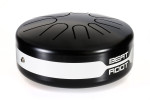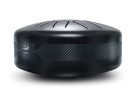The Tongue Drum
The tongue drum is a relatively new instrument in the idiophone family. It differs from string and wind instruments in that the sound it emits is produced by the material of the instrument itself.
The tongue drum can be played with the hands as well as with mallets. Its sound is very soft and relaxing.
The Tongue Drum is a percussion instrument for everyone with its intuitive approach to music. Young and old, musicians and amateurs, everyone can play it wonderfully well from the first try.
It is very easy to play and no particular knowledge of music is required to start playing it. The fact that no false note is possible makes it a very popular instrument for musical awakening. It is also used in music therapy and meditation.
The Hang
The Hang was invented in 2001 by a Swiss couple, Sabina Schärer and Felix Rohner. This instrument is the result of many years of research. Because of its originality and the fact that its manufacturing process is very long, when it was released the Hang drum quickly became a source of envy and a very big craze was created. The 2 creators are then obliged to set up a system of queue and letter of motivation for the people eager to put the hand on one of their creation. The Hang then becomes a very difficult instrument to obtain and the myth of the Hang begins to settle.
Unlike its ancestor the steel drum, it is not possible to play the Hang with sticks. It can only be played with the hands, which requires a rather studious learning for all the people having never made percussion.
Like the tongue drum, the Hang sound is crystalline and hypnotic. Its harmonies are however richer since when you tap on one of the notes of a Hang, there are in fact 3 notes that compose it. This explains the price difference between a tongue drum and a Hang.
The process of manufacturing the Hang is much more difficult because it is necessary to make sure that the 3 notes harmonize between them. When the maker hammers his notes to make them sound, he can't make a mistake because it is impossible to go back. If he makes a mistake on the 3rd note, he can throw away his instrument.
However, don't trust all the websites selling Hang on the internet. The creators of the Hang have officially stopped producing it. You will find on the market only imitations made in China of this magnificent instrument. These imitations are called Handpan and are only a pale reflection of the sound quality of the Hang.
The Handpan
Since the production of the Hang stopped, many people have tried to take over the creation of the Hang in order to ride the wave of popularity of this exorbitantly priced instrument. The name Hang having been reserved by the company making the Hang (PANart), the name that has been used for copies of the Hang is Handpan (in reference to PAN'art).
The lure of money for some or the passion of creation for others, it was very difficult to get an idea of the seriousness of the manufacturers who tried to propose their own version of the Hang. Since at that time the manufacture of a handpan could take up to a month to be made, at the time it was not possible to make a professional activity of it. But this changed with the appearance of the first industrially manufactured handpans in China.
Some people immediately understood the money that could be made in this new lucrative market and developed factories capable of producing them industrially. The manufacturing process now takes only a few hours, which has allowed the democratization of Handpans on a large scale but still with an exorbitant price of $1500 on average. Now Handpans made in China are available everywhere on the internet for the greatest pleasure of all, except perhaps the passionate craftsmen who always have at heart to privilege the sound quality than the money.
Steel Tongue Drum or Hang Drum or Handpan? Which one to choose?
The Tongue drum, the Hang and the Handpan have many similarities but there are some important differences that can help you make your decision.
The Price
The price is probably the most important difference between these instruments. The tongue drums are in a price range between $250 and $800. Handpans are in the range of $1500 to $3000, a much higher price range.
As said before, the Hang are not manufactured anymore but you can still find them second hand on the internet. Count on the other hand not less than $4000 for the original copies still on sale.
Be careful, however, not to buy a Hang that is out of tune. Hangs and Handpans are not very resistant to shocks and bad weather because of their less robust material than tongue drums. Buying a used Hang or Handpan is rather risky. Over the years, these instruments may have suffered shocks or have been poorly maintained, which has a direct impact on their notes since they are produced by the material of the instrument itself. The slightest dent and your whole range is distorted.
Availability
A handpan is usually made to order, which means that you have to be patient before you can get your hands on it. Once you have told the craftsman the scale you want in your handpan, the craftsman will take about 2 weeks to a month to make it.
Of course, it is also possible to find handpans available immediately with a huge choice of different scales in stock but these handpans are Chinese made. They are all the same and have an identical sound. They are industrially manufactured in factories in China and are offered for sale by internet marketing companies willing to make money by selling low quality instruments at exorbitant prices.
The price of a Hang was very expensive because it was impossible to manufacture a Hang quickly. The sound quality of the Hang was worth $1500 to $3000. This is no longer the case with these Handpan which are made in one hour by machines and whose price is always $1500. It is simply a rip-off.
Tongue drums are available more quickly due to their less time-consuming manufacturing process. Tongue drums are cut and not hammered, which makes the manufacturing process much faster with less waste during the manufacturing of the instrument.
We advise you to make sure that the company or website selling your handpan or tongue drum is the one that makes the instrument. If this is the case then you can be sure of the quality of the instrument you are buying. And if you can't find this information or if the website only displays nice sentences praising the merit of big-hearted manufacturers or carefully selected craftsmen, you can be sure that they are simply instruments coming from China with a more than doubtful quality.
The Music
The Hang or Handpan offers many more possibilities than the Tongue drum thanks to its central note. This note, which is called the pivot note, allows the connection between all the notes around the instrument.
A tongue drum, because of its small size, cannot have this central note or else it is at the expense of the sound quality of the other notes. The playing technique is then very different
The sounds of an original Hang are inimitable and its harmonies are recognizable among all.
The sound of a tongue drum or handpan varies greatly depending on the manufacturer. If it is a craftsman who makes his own instrument (like the Beat Root tongue drums for example), you can be sure that the quality will be there.
However, if you end up with a handpan or a tongue drum made in China (like the Zenapan or Zenadrum for example), you can be sure that the sounds will be very basic. You will always have a nice depth of note corresponding to these types of instruments but you will not have that pure immersion in soft, warm, crystal clear tones with depth in harmony with the melodious notes.
It is this purity in the notes that creates that feeling of well being when playing a tongue drum or handpan. If you only have the depth of the note and a metallic note, which may be beautiful in appearance because it is new to your ear but not at all crystalline and pure, you will miss the benefits of these instruments.
Also remember that it is not possible to play with sticks on a Handpan or Hang. To play with a handpan you will need to master the finger percussion technique which can be a bit tricky to learn. If you are looking for a more accessible instrument as a novice, we advise you to start with the tongue drum.
The Scales
The difference here is rather small since until now all tongue drums, handpans and hangs were composed of only one scale. Before choosing your instrument, you had to know which scale to choose - and when you know that you can't go back, that the price of this kind of instrument is not cheap, and that you will play for years with the same scale, you often took a long time to think about it before plunging into the tongue drum, handpan or hang adventure..
You may have noticed that I mention these adventures in the past tense, since with the appearance of the first multi-scale tongue drum of Beat Root, which combines 6 scales in a single tongue drum, this difficult choice is relegated to ancient history.
The appearance of a new type of tongue drum where you can change scales by moving magnets is quite simply a worldwide revolution in the tongue drum market. The Beat Root Multi Scale is ideal for those who want to learn the pleasure of playing the tongue drum without being limited to one scale.
The Size
A Hang or Handpan measures about 24 inches in diameter while a tongue drum measures about 12 inches in diameter.
Sustainability
The Hang or Handpan is more fragile because of its manufacturing process. The tuning of this instrument is done by hammering the metal, so the slightest deformation due to a shock or a bad play will deform the sheet metal and thus detune the instrument.
The tongue drum does not go out of tune, the tuning is anchored in the instrument thanks to the cutting of the tongues which will remain identical throughout the life of the instrument.
 Musical awakening: discovering music at any age
Musical awakening: discovering music at any age


